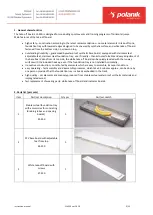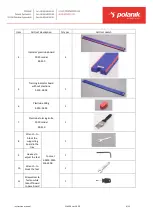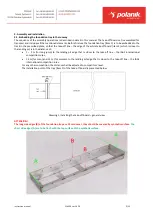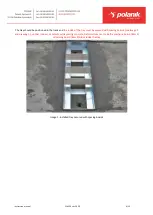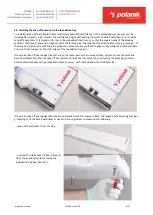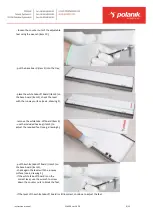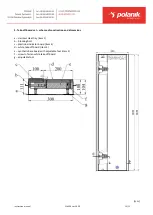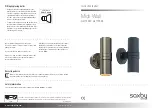
Instruction manual
S14-250 ver. 2020
12/15
4. Remarks on maintenance and operating
Plasticine strips deform during training sessions and competitions. There are two indicator plasticine boards (item 4), one
training indicator board without plasticine (item 5), one plasticine block and one forming knife (item 7) in the set. Thanks
to the two indicator boards you are able to replace the one with the deformed plasticine strips with the other one very
quickly. It is recommended that one should substitute plasticine board (item 4) with indicator board without plasticine
(item 5) for intensive training sessions. Training indicator board (item 5) is thinner and does not require the plasticine
forming.
Dents and defects in the plasticine layers should be filled up and leveled. First one ought to apply thick layers of
plasticine (item 6) on the damaged areas. Then the layers are to be leveled with the forming knife (item 7), as it is shown
below.
Attention! While storing or using plasticine should be protected against high temperatures (ove
r 40 °C), because
otherwise it can change its shape and dimensions, and in extreme cases it can become a liquid.
To ensure great aesthetics and high comfort for jumpers we use natural raw materials like wood and plywood. The
materials are not so durable as synthetic ones. Thus the wooden take-off board parts (white take-off board and
indicator boards) wear out faster and they need to be replaced. In order to maintain the parts in good condition they
should be removed from the embedded tray after competitions and training sessions and stored in a dry roofed place. It
is recommended that the embedded stainless steel tray (item 1) should be sheltered with the stainless steel cover (see
page 14). Any defects in paint coating revealed during thorough regular inspections of the wooden parts must be
repaired with wood paint or impregnant. Synthetic base board (item 2), stainless steel foundation tray (item 1) and
stainless steel blanking covers (available separately) do not require any additional maintenance actions.
Even though the wooden elements are impregnated and protected with paint, a prolonged contact with water can
devastate or deform them.
The white take-off board (item 3) can be, turned over and screwed again to the synthetic base board. That prolongs
sign
ificantly the product’s life.
Even the best technical solutions cannot substitute for common sense. The usage of the product must take place under
the supervision of qualified sports arena staff and trainers. The producer shall not be liable for any incidents caused by
the improper take-off board installation, assembly or its misuse.



